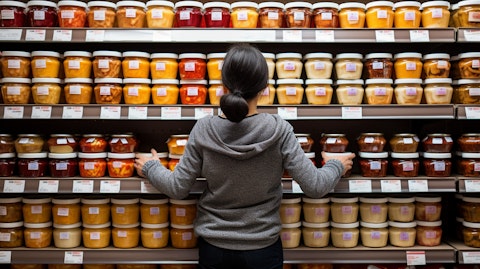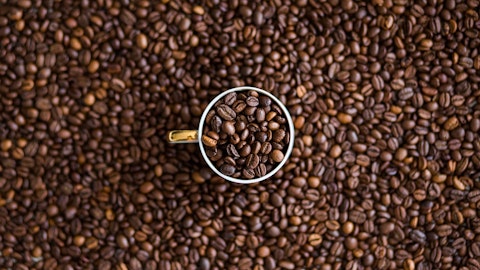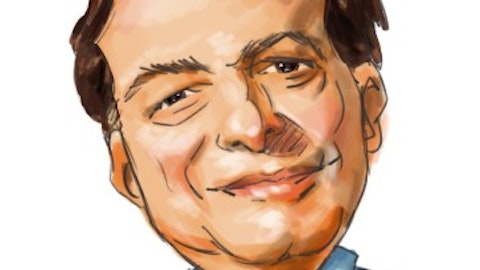The J. M. Smucker Company (NYSE:SJM) Q2 2024 Earnings Call Transcript December 5, 2023
The J. M. Smucker Company beats earnings expectations. Reported EPS is $2.59, expectations were $2.47.
Operator: Good morning and welcome to The J.M. Smucker Company’s Fiscal 2024 Second Quarter Earnings question-and-answer session. This conference is being recorded. [Operator Instructions] I’ll now turn the conference call over to Aaron Broholm, Vice President, Investor Relations. Please go ahead, sir.

Aaron Broholm: Good morning and thank you for joining our fiscal 2024 second quarter earnings question-and-answer session. I hope everyone had a chance to review our results as detailed in this morning’s press release and management’s prepared remarks which are available on our corporate website at jmsmucker.com. We will also post an audio replay of this call at the conclusion of this morning’s Q&A session. During today’s call, we may make forward-looking statements that reflect our current expectations about future plans and performance. These statements rely on assumptions and estimates and actual results may differ materially due to risks and uncertainties. Additionally, we use non-GAAP results to evaluate performance internally.
I encourage you to read the full disclosure concerning forward-looking statements and details on our non-GAAP measures in this morning’s press release. Participating on this call are Mark Smucker, Chair of the Board, President and Chief Executive Officer; and Tucker Marshall, Chief Financial Officer. We will now open up the call for questions. Operator, please queue up for question.
See also 15 Best States to Retire on Social Security and 13 Best Tech Stocks For Long Term Investment.
Q&A Session
Follow J M Smucker Co (NYSE:SJM)
Follow J M Smucker Co (NYSE:SJM)
Receive real-time insider trading and news alerts
Operator: [Operator Instructions] Our first question today is coming from Andrew Lazar from Barclays.
Andrew Lazar: I guess first off, part of, I think, the company’s initial 8.5% to 9.5% comparable sales growth target for fiscal ’24 I think it was inclusive of what we’d consider sort of true underlying organic growth of 4% with 3 points of volume growth. Pricing came in a bit higher than we thought this quarter and volume perhaps a bit lower. So curious if the 4% is still sort of your expectation and if the contribution from Vim is still the same around 3 points of that.
Tucker Marshall: Andrew, so underpinning our comparable net sales growth of 8.5% to 9% after isolating the co-manufacturing volume and the Jif peanut butter product recall, we are still anticipating 4 points of top line growth. And within that 4 points is 3 points of volume mix and 1 point of price.
Andrew Lazar: Right. And then I think you said you’re expecting host of sales this fiscal year of about $650 million. Obviously, if one just annualizes that, it’s $1.3 billion and we know that’s below the $1.5 billion that you initially talked about. But my sense is there are a number of puts and takes to consider and that it’s kind of an oversimplification just to annualize the $650 million. So I was hoping you could go into that a little bit and give us a sense of what the puts and takes are. So we have a sense of what you see as the sort of the true, let’s call it, annualized sales outlook for this business right now.
Tucker Marshall: So Andrew, the $650 million reflects calendarizing the Hostess performance on the Smucker fiscal year. The second component is it reflects the time of ownership since the transaction closing. And so there is 1 week of lost sales in the 6-month period. We approximate that to be about $25 million. And then also, we are assuming the business in a bit of a seasonality or a period of low across October, November, December and January, as you think about the holiday season, the holiday bank. And then also as you think about New Year’s resolutions, so I think you would want to account for that in your annualization. And then lastly, there’s a few transitory dynamics that the company is working through. One, it just relates to competition and competition’s return to supply on shelf.
And two is some dynamics with the customer around getting product from the back of store on to shelf. And so those will restore here in the coming months and will also support the annualization. But as we’ve noted in our prepared remarks, we are committed to the top line growth of 4% for this portfolio and we do see growth in fiscal ’25 and accretion from the bottom line standpoint as well.
Operator: Next question is coming from Ken Goldman from JPMorgan.
Ken Goldman: Just to follow up on the comment that was just made about competition. Just so I understand a little bit more clearly that competitor, I assume we’re talking about McKee; they’ve been back on shelf for over a year now. Their supply chain issues we’re lapping the recovery there. So I’m just curious a little bit why this would be new or something that would be cited as sort of a, I guess, a nonrecurring headwind and also it doesn’t really go away, I assume, it’s going — something that’s going to be there for a while. So I just kind of wanted to make sure I understood that comment a little bit.
Mark Smucker: Ken, it’s Mark. So in your question, I think one thing where you’re right is we are lapping some of that and we were aware of some of those issues as we obviously took on the business. So we don’t have a ton of concern there we’re — ultimately, we’re extremely excited about this business. We think that it is a perfect fit at a very good time for our company as we have completely reshaped our portfolio, gotten exceptionally focused on the brands and the categories that really matter and are going to drive growth, along with the capabilities that we have been building. So it is a little bit of timing. And if you think about the Hostess business and what it brings to the table, again, a leading brand in a growing category, we’ve got some very strong capabilities that we have built.
They’ve got some great capabilities in innovation in C-store. And so we just are very optimistic about the combination of these businesses, the complementary nature of the capabilities and our ability to continue to grow the business and the expectation that it will be accretive in our next fiscal year.
Ken Goldman: Okay. And then can you walk us through a little bit of sort of how you see the cadence of gross margin for the rest of the year? Obviously, we can kind of back into the implied rough number but you had your, I think, in 6 years on an adjusted basis, you talked about pricing, lower coffee cost and volume mix that helped. But your guidance implies that it will be a little bit lower in the back half which also, I think, suggests that maybe some of what helped 2Q was somewhat nonrecurring. So just curious, is that the right way to think about it? And if so which of those benefits to 2Q might fade a little bit or I am thinking about that the wrong way?
Tucker Marshall: So our guidance for the full year is 37.5% gross margin. And what we saw was a very strong second quarter where we came in about 38.7%. As we think about the third and the fourth quarter, the third quarter will be a bit softer than where we landed in the second quarter and then it will be a bit stronger in our fourth quarter in order to get you to our current outlook for gross profit for the full year.
Operator: Next question is coming from Robert Moskow from TD Cowen.
Robert Moskow: I wanted to know about the profit contribution that you’ve forecasted for Hostess for the rest of the fiscal year, $120 million. Is that — it does look lower than what consensus estimates were for Hostess prior to the deal. And I want to know, given that you’ve lowered the sales, have you also had to lower the profit expectation. And does that include any kind of plans for reinvestment or just doing something to kind of get the sales growth reaccelerating so you head into fiscal ’25 in good shape?
Tucker Marshall: So Rob, the outlook for segment profit for the Sweet Bank Snacks is approximately $150 million of segment profit contribution or about $1.11 from an EPS standpoint. Yes, we did soften that based on top line but we expect that to restore as we move forward beyond this fiscal year. There are a few opening balance sheet items incorporated in there that offer about $0.05 impact to segment profit. And we continue to support the Hostess organization with reinvestment in the business in order to support the brand growth and development.





